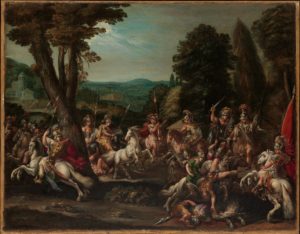
The Triumph of the Amazons, Claude Déruet, 1620s.
The Amazons were a race of female warriors in Greek mythology who were believed to have inhabited an island made up of exclusively women. These Amazonians were one of the most powerful female images to have come from ancient Greek culture and mythology. They personified the idea of female independence and women have total control over their own lives. These warrior women were said to have spurned men except in order to reproduce. In this circumstance, they would undergo a yearly mating ritual with men who were usually residing on a nearby island. Any daughters that resulted from this union would be kept and trained in order to become the next generation of warriors. Sons would either be exposed or were sent back to live with their father. This ensured the continuance of female exclusivity on their island. One Amazonian Queen, Thalestris, went further than this and was shown to have only reproduced with royal men such as kings and princes. This was done in order to preserve her regal status and the strength of any of her offspring.
The Amazonian women are depicted in artwork as having ivy-shaped shields which they used alongside double bladed axes. They were often shown as having one breast bared on the battlefield. These women are thought to be representations of the deity Athena, as they were always seen holding some form of weapon. Both their shield and helmet were also very similar to the goddess. Later art shows them closer representing Artemis, as they are wearing a short Persian style tunic. These representations differ from other accounts where Amazonian women were said to have had their right breast removed in childhood. This was done in order to use their bow more effectively. These images clearly contradict each other and it would appear that the supposed breast removal resulted from a need by ancient Greek men to dehumanise these women. This would also have simultaneously attacked their femininity.
The Amazons feature in several mythological battles, most often as opponents of the Greeks. In these they would be defeated by a prominent Greek hero. An example of this is part of the Twelve Labours of Heracles, also known as Hercules. As part of this, he was required to obtain the girdle of Queen Hippolyta as his Ninth Labour in his quest for immortality and a place on Olympus. There are two endings to this story; the first shows Queen Hippolyta dying on the battlefield. The second shows her living through the labour and leading an attack on Athens in revenge for her prior abduction by Theseus. This second variation explores how Hippolyta had been kidnapped and raped by Theseus, resulting in the child Hippolytus before she escaped. Heracles later approached her and asked for her girdle which she agreed to surrender without a fight. This enraged Hera who then disguised herself as an Amazonian woman to spread a rumour that Queen Hippolyta was being abducted for a second time. In his haste, Heracles killed Hippolyta for the girdle and managed to flee the warrior women.
The Amazons also featured in the Trojan War under the command of their Queen, Penthesilea. She was said to have led her troops into Troy in order to support King Priam from Agamemnon and the Greeks during the war. Penthesilea slayed the Greek’s Machaon, translated as ‘physician’ and paid the price with her life by the hand of Achilles. Upon lifting her helmet, Achilles was said to have fallen madly in love with her. As a result, he agreed to allow the return of her body to the Trojans so that a proper burial could be carried out.
These women may have actually existed as the Greeks believing that they controlled the Black Sea between 1000-600 BCE. As their knowledge of the surrounding regions became more extensive, the island of the Amazons was said to exist further and further away. Archaeologists have found evidence in the Black Sea region of a mounted nomadic warrior race. This race may possibly be the remains of the Amazonian women. It has also been argued that these women were a projection of the male Greek mind. They were created as a warning of what would happen should women have the authority to act however they pleased.
-Devon Allen
Junior Girl
Girl Museum Inc.
